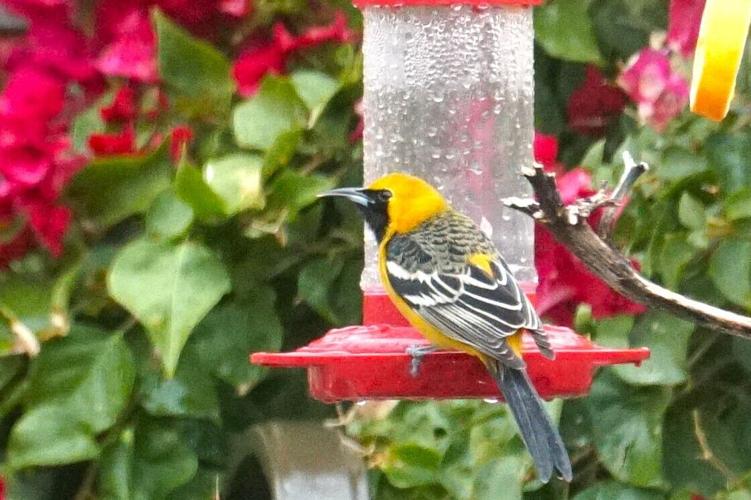As I write this column (on Tuesday, January 9), there have been a pair of Streak-backed Orioles observed 90 miles north of SaddleBrooke at the Riparian Reserve at Gilbert Water Ranch since Sunday, November 19, 2023. If this bird name doesn’t ring a bell with you, that’s probably because it isn’t a bird from the United States. It’s a Mexican bird, and not a just-across-the-border bird, because it isn’t found in numbers until you get to Alamos, 500 miles south of here. This phenomenon is uncommon and rare but hardly unheard of, and birders in general love it, since it gives them a chance to record rare birds without using their passport.
Similarly, we had a male Hooded Oriole overwinter in our backyard during the winter of 2010 to 2011, and we thought we had a second one this winter when we recorded a male Hooded Oriole for six weeks, from Monday, November 13, 2023, until he was last seen on Thursday, January 4. He had apparently disappeared when a different male Hooded Oriole, this one a juvenile without all the black feathers of the previous adult bird, appeared on Monday, January 8, and again, this morning, on Tuesday, January 9. These orioles normally spend the winter in Mexico, south to Belize, and typically show up in Arizona in March to build hanging nests woven out of palm fronds (they were once called Palm-leaf Orioles). Normally, they raise a family and then return to Mexico by mid-September. If you wonder, like I do, what motivates a bird to flout the normal course of events, just remember my birding friend Rick’s conclusion: Birds have wings and don’t read maps.
What adds to the remarkableness of these occurrences and observations is that this movement of the birds is rarely documented until they ‘show up’ somewhere they aren’t expected. Why our orioles haven’t been documented before they arrived at our house is a puzzle, and the same can be said for the Streak-backed Orioles which are hanging out at the Water Ranch. There are LOTS of birders around, and these birds covered a LOT of territory, yet no one reported any Streak-backs south of the Water Ranch, and no one has reported any Hooded Orioles anywhere in Arizona except for two south, not north of here, in Green Valley for a single day twice in mid-December. Maybe these orioles only cover large distances at night?
U.S. populations of Hooded Orioles have been in flux since the mid-twentieth century, expanding in some areas and declining in others. A major decline in the Santa Ana Wildlife Refuge in the lower Rio Grande area of Texas is well-documented, with four hundred breeding pairs recorded in the late 1940s dropping to zero by 1971. Since then, they have begun recovering, but are still largely absent. Range expansion in California and Arizona appears to have resulted from increasing planting of fan palms and other exotic plants, especially on or near waterways. Currently, in the U.S. the Hooded Oriole is mostly limited to summertime breeding in California, southern Utah, Arizona, New Mexico and Texas. Another population depressant is the proclivity of parasitism, especially from the Bronzed Cowbird, which loves to lay its eggs in Hooded Oriole nests, often after destroying previously laid oriole eggs, and then leaving the raising of the cowbird chicks to the orioles.
If you want to see the Streak-backed Orioles at the Riparian Reserve at Gilbert Water Ranch, follow your GPS to the parking area for the Water Ranch and then take a short walk (less than a mile and level) to an area between ponds three and four. The birds have appeared in one single area, and you will find other birders waiting and watching for them. Someone has hung orange slices from nearby trees, although park personnel seem intent to remove these. In the meantime, check your hummingbird feeders for one of ‘our’ Hooded Orioles. Even if you don’t see an oriole, we have three species of hummingbirds who live here year-round, so, you should keep at least one hummingbird feeder up twelve months of the year. And if the temperature drops below freezing, make sure your sugar water doesn’t freeze. If it does, just zap your feeders in the microwave to keep your birds happy.
If you have questions or comments about SaddleBrooke’s birds, or to receive emailed information about bird walks led by Bob and Prudy, call (520) 825-9895 or email bobandpru@gmail.com. Previously published articles can be found online at birdingthebrookeandbeyond.com.







